NCERT Exemplar: Sexual Reproduction in Flowering Plants - 1 | Biology Class 12 - NEET PDF Download
Multiple-Choice Questions
Q.1. Among the terms listed below, those that are not technically correct names for a floral whorl are:
i. Androecium
ii. Carpel
iii. Corolla
iv. Sepal
(a) i and iv
(b) iii and iv
(c) ii and iv
(d) i and ii
Ans. (c)
Solution:
- There are 4 floral whorls viz., calyx, corolla, androecium and gynoecium. Calyx and corolla are accessory organs or non-essential whorl, while androecium and gynoecium are reproductive organs.
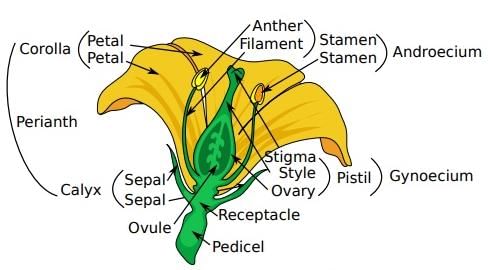 Different floral whorls
Different floral whorls - The calyx is the outermost whorl of the flower, and the members are called sepals.
- The gynoecium is the female reproductive part of the flower and comprises one or more carpels.
Q.2. The embryo sac is to ovule as _______ is to an anther.
(a) Stamen
(b) Filament
(c) Pollen grain
(d) Androecium
Ans. (c)
Solution:
- Embryo sac (female gametophyte) → Ovule (megasporangium)
- Pollen grain (male gametophyte) → Anther (microsporangium)
Q.3. In a typically complete, bisexual and hypogynous flower, the arrangement of floral whorls on the thalamus from the outermost to the innermost is:
(a) Calyx, corolla, androecium and gynoecium
(b) Calyx, corolla, gynoecium and androecium
(c) Gynoecium, androecium, corolla and calyx
(d) Androecium, gynoecium, corolla and calyx
Ans. (a)
Solution:
Arrangement of floral whorls on the thalamus from the outermost to the innermost is :
► Calyx → Corolla → Androecium → Gynoecium.
Q.4. A dicotyledonous plant bears flowers but never produces fruits and seeds. The most probable cause for the above situation is:
(a) Plant is dioecious and bears only pistillate flowers.
(b) Plant is dioecious and bears both pistillate and staminate flowers.
(c) Plant is monoecious.
(d) Plant is dioecious and bears only staminate flowers.
Ans. (d)
Solution: A dicotyledonous plant bears flowers but never produces fruits and seeds because it is dioecious and bears only staminate flowers.
Q.5. The outermost and innermost wall layers of microsporangium in an anther are respectively:
(a) Endothecium and tapetum
(b) Epidermis and endodermis
(c) Epidermis and middle layer
(d) Epidermis and tapetum
Ans. (d)
Solution:
Wall layers of microsporangium in an anther are:
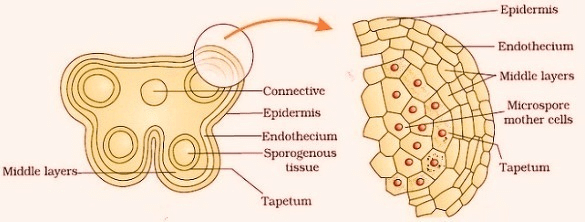 MicrosporangiumQ.6. During microsporogenesis, meiosis occurs in:
MicrosporangiumQ.6. During microsporogenesis, meiosis occurs in:
(a) Endothecium
(b) Microspore mother cells
(c) Microspore tetrads
(d) Pollen grains
Ans. (b)
Solution: During microsporogenesis, meiosis occurs in microspore mother cells.
Q.7. From Among the sets of terms given below, identify those that are associated with the gynoecium.
(a) Stigma, ovule, embryo sac, placenta
(b) Thalamus, pistil, style, ovule
(c) Ovule, ovary, embryo sac, tapetum
(d) Ovule, stamen, ovary, embryo sac
Ans. (a)
Solution: Stigma, ovule, embryo sac and placenta are associated with the gynoecium.
- Stigma is a part of pistil on which pollen grain lands.
- Each ovary may have many ovules, which have embryo sacs in them.
- The placenta is a tissue/ridge inside ovary to which ovules are attached.
- Thalamus is the terminal part of the axis of a flower which bears all floral appendages.
- Tapetum is the innermost layer of microsporangium while stamen is part of androecium.
Q.8. Starting from the innermost part, the correct sequence of parts in an ovule is:
(a) Egg, nucellus, embryo sac, integument
(b) Egg, embryo sac, nucellus, integument
(c) Embryo sac, nucellus, integument, egg
(d) Egg, integument, embryo sac, nucellus
Ans. (b)
Solution:
The correct sequence of parts in an ovule is:
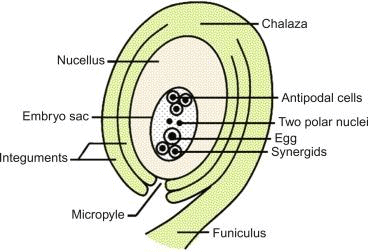 Ovule
Ovule
- The ovule or the megasporangium is present within the ovary of the Gynoecium. Two layers of the integument protect each ovule.
- The integuments enclose the nucellus. At maturity, one or more cells of the nucellus differentiate to form the Megaspore Mother Cell.
- This cell undergoes meiotic division to form the embryo sac or the female gametophyte. The egg apparatus is present within the embryo sac.
So, the correct answer is 'Egg, embryo sac, nucellus, integument.'
Q.9. From the statements given below, choose the option that are true for a typical female gametophyte of a flowering plant:
i. It is 8-nucleate and 7-celled at maturity.
ii. It is free-nuclear during the development.
iii. It is situated inside the integument but outside the nucellus.
iv. It has an egg apparatus situated at the chalazal end.
(a) i and iv
(b) ii and iii
(c) i and ii
(d) ii and iv
Ans. (c)
Solution:
- A typical female gametophyte or the embryo sac in Angiosperms consists of an egg apparatus situated at the micropylar end, two polar nuclei at the centre and three antipodal cells at the chalazal end of the ovule.
- The megaspore mother cell undergoes meiotic division to produce four megaspores, of which, three degenerate and only one is functional.
- This megaspore undergoes three mitotic divisions to form 8 nuclei, hence, a free nuclear division.
- Out of the 8 nuclei, three move to the chalazal end and form the antipodal cells.
- Three form the egg apparatus at the micropylar end, while two nuclei occupy the central region, forming a single-celled binucleate polar cell at maturity.
Q.10. Autogamy can occur in a chasmogamous flower if:
(a) Pollen matures before the maturity of an ovule.
(b) Ovules mature before the maturity of pollen.
(c) Both pollen and ovules mature simultaneously.
(d) Both anther and stigma are of equal lengths.
Ans. (c)
Solution: In a normal flower that opens and exposes the anthers and stigma complete autogamy is rare.
Autogamy in such flowers requires synchrony in pollen release and stigma receptivity. Also, the anthers and the stigma should lie close to each other so that self-pollination can occur.
Q.11. Choose the correct statement from the following:
(a) Cleistogamous flowers always exhibit autogamy.
(b) Chasmogamous flowers always exhibit geitonogamy.
(c) Cleistogamous flowers exhibit both autogamy and geitonogamy.
(d) Chasmogamous flowers never exhibit autogamy.
Ans. (a)
Solution:
- Cleistogamous flowers are invariably autogamous as there is no chance of cross-pollen landing on the stigma.
- Cleistogamous flowers produce assured seed-set even in the absence of pollinators.
Examples of cleistogamous flowers are: Viola (common pansy), Oxalis, Commelina, Arachis hypogea and Oryza sativa.
Q.12. A particular species of the plant produces light, non-sticky pollen in large numbers and its stigmas are long and feathery. These modifications facilitate pollination by:
(a) Insects
(b) Water
(c) Wind
(d) Animals
Ans. (c)
Solution:
- Pollination by wind is called anemophily.
- Anemophilous flowers are small, inconspicuous non-scented without bright colours, nectar and fragrance.
- Wind pollination also requires that the pollen grains are light and non-sticky, which is in large numbers and its stigmas are long and feathery.
Q.13. From among the situations given below, choose the one that prevents both autogamy and geitonogamy.
(a) Monoecious plant bearing unisexual flowers.
(b) Dioecious plant bearing only male or female flowers.
(c) Monoecious plant with bisexual flowers.
(d) Dioecious plant with bisexual flowers.
Ans. (b)
Solution:
- Autogamy (same flower), geitonogamy (different flowers of same plants; xenogamy (different plant’s flower)
- A dioecious plant bearing only male or female flowers prevents both autogamy and geitonogamy.
Q.14. In a fertilised embryo sac, the haploid, diploid and triploid structures are:
(a) Synergid, zygote and primary endosperm nucleus.
(b) Synergid, antipodal and polar nuclei.
(c) Antipodal, synergid and primary endosperm nucleus.
(d) Synergid, polar nuclei and zygote.
Ans. (a)
Solution:
- Synergids are pair of haploid cells present at the micropylar end of embryo sac.
- Zygote which is a diploid structure. It undergoes divisions to form an embryo.
- Antipodal and polar nuclei are also haploid in nature.
- Primary endosperm nucleus is triploid in nature.
- In a fertilised embryo sac the haploid, diploid and triploid structures are synergid, zygote and primary endosperm nucleus because antipodal is haploid in nature.
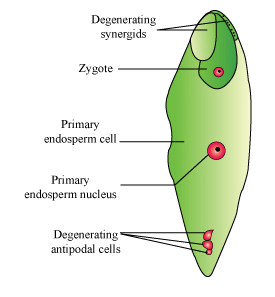 Mature embryo sac of an angiosperm
Mature embryo sac of an angiosperm
Q.15. In an embryo sac, the cells that degenerate after fertilisation are:
(a) Synergids and primary endosperm cell
(b) Synergids and antipodals
(c) Antipodals and primary endosperm cell
(d) Egg and antipodals
Ans. (b)
Solution: In an embryo sac, synergies, and antipodals degenerate after fertilization.
The following conversion takes place:
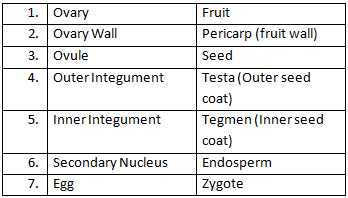
Q.16. While planning for an artificial hybridization programme involving dioecious plants, which of the following steps would not be relevant:
(a) Bagging of a female flower.
(b) Dusting of pollen on the stigma.
(c) Emasculation
(d) Collection of pollen.
Ans. (c)
Solution:
- Artificial hybridisation is human performed crossing of two different plants with complementary good traits to obtain an overall superior variety.
- Plant breeders have used artificial hybridisation for the crop improvement programme.
- Two precautionary measures in artificial hybridisation are emasculation and bagging.
- Emasculation is the removal of stamens from the floral buds so that chances of self-pollination are eliminated.
- In dioecious (unisexual) plants, emasculation is not required as they have either male or female flowers.
Q.17. In the embryos of a typical dicot and a grass, true homologous structures are:
(a) Coleorhiza and coleoptile
(b) Coleoptile and scutellum
(c) Cotyledons and scutellum
(d) Hypocotyl and radicle
Ans. (c)
Solution:
- Cotyledons of the typical dicot embryo are simple structures generally thick and swollen due to storage of food reserves (as in legumes).
- The embryo of monocots consists of one large and shield-shaped cotyledon known as scutellum situated towards one side (lateral) of the embryonal axis.
Example: Grass family, Sorghum.
Q.18. The phenomenon observed in some plants wherein parts of the sexual apparatus is used for forming embryos without fertilisation is called:
(a) Parthenocarpy
(b) Apomixis
(c) Vegetative propagation
(d) Sexual reproduction
Ans. (b)
Solution:
- Apomixis is a special mechanism to produce seed without fertilisation. It is observed in few flowering plants such as some species of Asteraceae and grasses.
- Apomixis is a form of asexual reproduction that mimics sexual reproduction. If the fruit is formed without fertilisation of ovary, it is called a parthenocarpic fruit.
Example: Banana and grape.
Q.19. In a flower, if the megaspore mother cell forms megaspores without undergoing meiosis and if one of the megaspores develops into an embryo sac, its nuclei would be:
(a) Haploid
(b) Diploid
(c) A few haploid and a few diploid
(d) With varying ploidy
Ans. (b)
Solution:
- Meiosis is the reductional division, and this occurs in the megaspore mother cell so that the diploid cell divide and form a haploid gamete.
- If the megaspore mother cell does not undergo meiosis, then the ploidy of the embryo sac will be 2n or diploid.
Q.20. The phenomenon wherein, the ovary develops into a fruit without fertilisation is called:
(a) Parthenocarpy
(b) Apomixis
(c) Asexual reproduction
(d) Sexual reproduction
Ans. (a)
Solution: If the fruit is formed without fertilisation of ovary, it is called a parthenocarpic fruit.
Example: Banana and grape.
Very Short Answer Type Questions
Q.1. Name the component cells of the ‘egg apparatus’ in an embryo sac.
Ans. Egg apparatus has three cells—one egg cell and two synergids.
Q.2. Name the part of gynoecium that determines the compatible nature of pollen grain.
Ans. The stigma of carpel/ pistil determines compatible nature of pollen grain.
Q.3. Name the common function that cotyledons and nucellus perform.
Ans. Both cotyledons and nucellus provide nourishment.
Q.4. Complete the following flow chart

Ans.

Q.5. Indicate the stages where meiosis and mitosis occur (1, 2 or 3) in the flow chart.
 Ans. Stages:
Ans. Stages:
Q.6. The diagram given below shows the path of a pollen tube from the pollen on the stigma into the embryo sac. Name the components of the egg apparatus.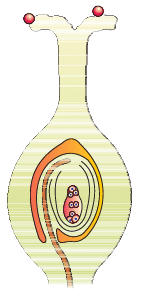 Ans. Components of egg apparatus: one egg cell and two synergids.
Ans. Components of egg apparatus: one egg cell and two synergids.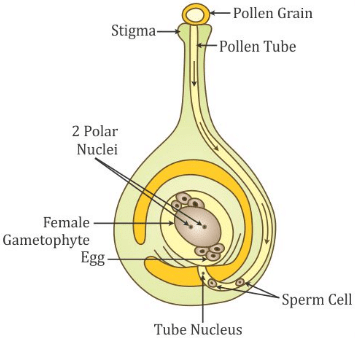 Egg
Egg
Q.7. Name the parts of the pistil which develop into fruit and seeds.
Ans. Ovary of pistil develops into the fruit while ovules develop into seeds.
Q.8. In the case of polyembryony, if an embryo develops from the synergid and another from the nucellus which is haploid and which is diploid?
Ans. Synergid embryo is haploid, and the nucellar embryo is diploid.
Q.9. Can an unfertilised, apomictic embryo sac give rise to a diploid embryo? If yes, then how?
Ans. Yes, if the embryo develops from the cells of nucellus or integument, it will be diploid.
Q.10. Which are the three cells found in a pollen grain when it is shed at the three celled stage?
Ans. One vegetative cell and two male gametes.
Q.11. What is self-incompatibility?
Ans. The device to prevent inbreeding is self-incompatibility or self-sterility. This is a genetic mechanism and prevents self-pollen (from the same flower or other flowers of the same plant) from fertilising the ovules by inhibiting pollen germination or pollen tube growth in the pistil.
Q.12. Name the type of pollination in self-incompatible plants.
Ans. Xenogamy.
Q.13. Draw the diagram of a mature embryo sac and show its 8-nucleate, 7-celled nature. Show the following parts: antipodals, synergids, egg, central cell, polar nuclei.
Ans.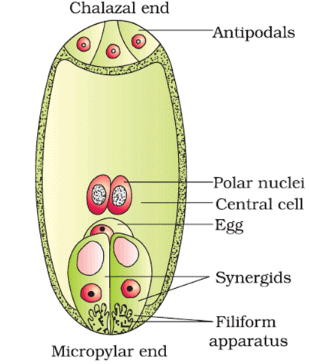
Q.14. Which is the triploid tissue in a fertilized ovule? How is the triploid condition achieved?
Ans. The triploid tissue in the ovule is the endosperm. Its triploid condition is attained due to the fusion of two polar nuclei and one nucleus of the male gamete (also called triple fusion).
Q.15. Are pollination and fertilization necessary in apomixis? Give reasons.
Ans.
- No, they are not necessary. Apomixis is actually an alternative to sexual reproduction, although the female sexual apparatus is used in the process.
- In apomicts, embryos can develop directly from the nucellus or synergid or egg. Therefore, there is no need for either pollination or fertilisation.
Q.16. Identify the type of carpel with the help of diagrams given below: Ans.
Ans.
(a) Multicarpellary, Syncarpous pistil or Papaver
(b) Multicarpellary, apocarpous gynoecium of Michelia
Q.17. How is pollination carried out in water plants?
Ans.
- Pollination by water is called hydrophily. Some examples of water pollinated plants are Vallisneria and Hydrilla (both are angiospermic hydrophytes) which grow in fresh water and several marine sea-grasses such as Zostera. Not all aquatic plants use water for pollination.
- In most aquatic plants such as water hyacinth and water lily, the flowers emerged above the level of water and pollinated by insects or wind as in most of the land plants.
Q.18. What is the function of the two male gametes produced by each pollen grain in angiosperms?
Ans.
- After entering one of the synergids, the pollen tube releases the two male gametes into the synergid cytoplasm.
- One of the male gametes moves towards the egg cell or oosphere and fuses with its nucleus, thus completing the syngamy. This results in the formation of a diploid cell, the zygote.
- The other male gamete moves towards the two polar nuclei located in the central cell and fuses with them to produce a triploid primary endosperm nucleus (PEN).
|
65 videos|390 docs|202 tests
|
FAQs on NCERT Exemplar: Sexual Reproduction in Flowering Plants - 1 - Biology Class 12 - NEET
| 1. What is sexual reproduction in flowering plants? |  |
| 2. How do flowering plants reproduce sexually? |  |
| 3. What are the different types of pollination in flowering plants? |  |
| 4. What is the significance of sexual reproduction in flowering plants? |  |
| 5. What are the reproductive structures in flowering plants? |  |

















